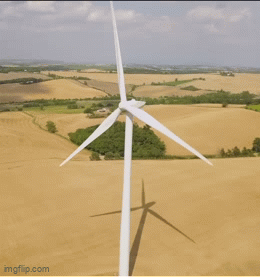“Wind Energy” refers to the energy derived from the movement of the wind. It is a form of renewable energy that is harnessed using wind turbines to generate electricity. As the wind blows, it turns the blades of the turbine, which then converts this kinetic energy into mechanical energy and, subsequently, into electrical energy. Wind energy is considered a clean and sustainable source of power because it does not produce greenhouse gases or other pollutants during operation.

Components of a Wind Turbine
These components work together to convert wind energy into electrical energy efficiently, making wind turbines a crucial part of renewable energy.
- Blades:
- Description: The blades are the parts exposed to the wind and rotate when the wind blows. They are typically made from lightweight yet strong materials like fiberglass or carbon fiber. The design of the blades helps improve the efficiency of the turbine by increasing the lift force.
- Hub:
- Description: The hub is the central part that connects the blades and transfers the rotational movement from the blades to the mechanical motion. It is the central component that holds the blades and directs them.
- Main Shaft:
- Description: The main shaft transmits the mechanical energy from the hub to the generator. It acts as the primary rotating axis in the turbine.
- Generator:
- Description: The generator converts the mechanical energy from the main shaft into electrical energy through electromagnetic induction.
- Nacelle:
- Description: The nacelle is the housing that contains the generator, main shaft, and other mechanical systems. It sits on top of the tower and rotates with the blades to face the wind direction.
- Tower:
- Description: The tower is the structure that supports the nacelle and the blades. It elevates the turbine off the ground to avoid obstacles and increase efficiency.
- Yaw Mechanism:
- Description: This mechanism adjusts the nacelle and blades to face directly into the wind. It includes motors and control systems that orient the turbine based on wind direction.
- Control System:
- Description: The control system includes sensors and software to manage the turbine’s operation. It monitors wind speed and direction and adjusts the turbine to prevent issues and ensure optimal performance.
- Pitch Mechanism:
- Description: This system adjusts the angle of the blades to change the amount of wind energy captured and regulate the turbine’s speed. It helps protect the turbine from overload.
- Safety System:
- Description: This system includes devices to ensure the safety of the turbine, such as automatic shutdown mechanisms in case of emergencies or severe weather conditions.
How Does a Wind Turbine Work?
A wind turbine generates electricity using the wind. Its force turns the blades of a rotor, which sets an alternator in motion.

The Rotation of the Blades
A wind turbine typically consists of three blades mounted on a rotor. This assembly is fixed to a nacelle that houses a generator and is installed at the top of a vertical mast. Thanks to the information transmitted by the weather vane that determines the wind direction, the rotor is positioned to continuously face the wind. The blades start to move when the anemometer indicates a wind speed of about 10 km/h at the hub height. The rotor is located at the top of a mast because the winds are stronger at higher altitudes. Depending on the type of wind turbine and the characteristics of the site, the height of the mast varies.
Electricity Production
The rotor drives a shaft in the nacelle, which is connected to an alternator.
The rotor’s rotational speed is 12 to 15 revolutions per minute, which is not sufficient for the alternator to operate properly. A gearbox is therefore placed just before the alternator to increase the rotation speed to around 1,500 revolutions per minute.
Thanks to the energy provided by the rotation of the shaft, the alternator produces an alternating current with a frequency of 50 Hz and a voltage of 400 to 690 V.
Voltage Adaptation
The voltage is then increased to 20,000 V by a transformer located in each wind turbine before being injected into the public electricity grid.
When the wind speed, indicated by the anemometer, reaches speeds of more than 90 km/h, the wind turbine stops operating for safety reasons. Two braking systems ensure the safety of the wind turbine:
- The first is by feathering the blades, which is an aerodynamic braking: the blades take on an orientation parallel to the wind;
- The second is by a mechanical brake on the drive shaft inside the nacelle.

Thanks for sharing. I read many of your blog posts, cool, your blog is very good.
Your article helped me a lot, is there any more related content? Thanks! https://accounts.binance.com/fr-AF/register?ref=JHQQKNKN
welcome
Thanks for sharing. I read many of your blog posts, cool, your blog is very good.
Thanks for sharing. I read many of your blog posts, cool, your blog is very good.
Thank you for your sharing. I am worried that I lack creative ideas. It is your article that makes me full of hope. Thank you. But, I have a question, can you help me?